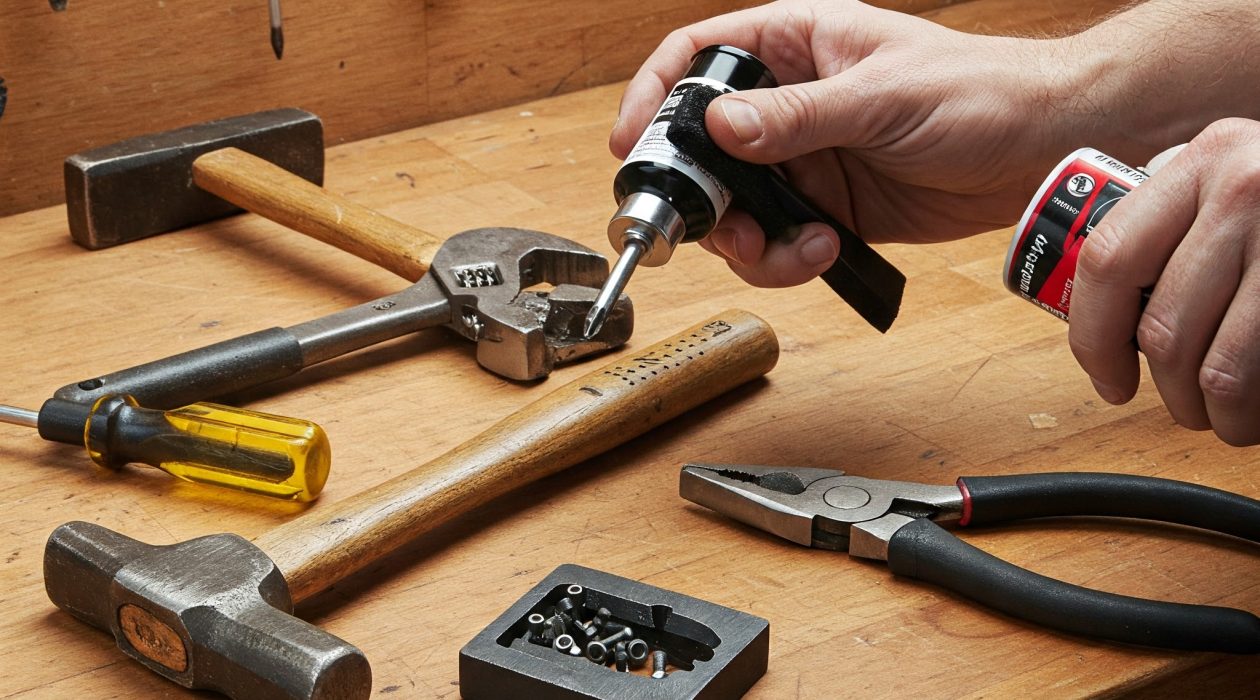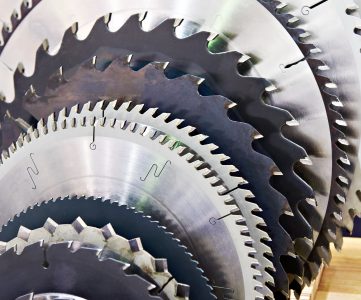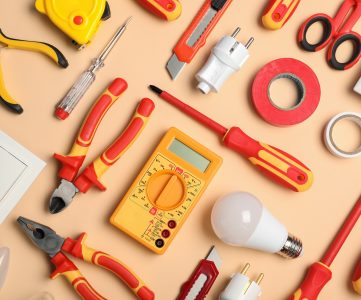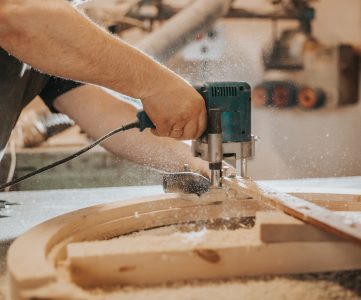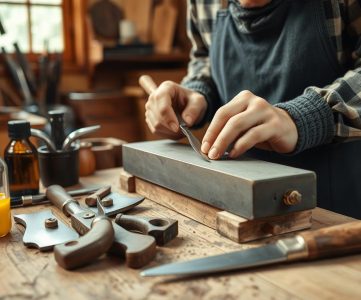Proper tool maintenance is key to extending your hand tools’ lifespan, ensuring safety and efficiency. By adopting the right care techniques, you can maintain their peak condition and maximize your investment. Regular upkeep is vital to prevent damage and reduce replacement needs.
Effective tool maintenance combines cleaning, storage, and upkeep. Incorporating these practices into your routine offers several benefits. You’ll see improved tool performance and longer tool life. Caring for hand tools is a simple yet effective way to safeguard your investment and ensure optimal tool function.
By focusing on tool maintenance, you can avoid the pitfalls of neglect. This includes reduced performance and increased accident risks. With the right strategies, you can maintain your hand tools in excellent condition. Enjoy the benefits of a well-maintained toolkit.
Key Takeaways
- Regular tool maintenance is essential for extending the lifespan of your hand tools
- Caring for hand tools involves a combination of cleaning, storage, and upkeep
- Proper tool maintenance can improve performance and reduce the need for frequent replacements
- Effective tool maintenance can help prevent damage and reduce the risk of accidents
- By prioritizing tool maintenance, you can protect your investment and enjoy the benefits of a well-maintained toolkit
- Tool maintenance is a simple yet effective way to keep your hand tools in top shape
The Importance of Regular Tool Maintenance
Regular tool maintenance is crucial for extending tool lifespan and ensuring optimal performance. By following proper hand tool care tips, you can prevent premature wear and tear. This reduces the need for frequent replacements, saving you money and ensuring your safety while working with tools.
Proper maintenance can be achieved through simple practices such as cleaning and storing tools correctly. Regular cleaning helps remove dirt and debris that can cause damage to tools. Proper storage prevents tools from getting lost or damaged. By implementing these practices, you can significantly extend the lifespan of your tools and reduce maintenance costs.
Some key benefits of regular tool maintenance include:
- Extended tool lifespan
- Improved tool performance
- Enhanced safety
- Cost savings
By prioritizing regular tool maintenance, you can ensure your tools remain in good condition. This reduces the risk of accidents and injuries. Proper maintenance also helps you identify potential issues before they become major problems. This allows you to take corrective action and prevent costly repairs.
By following these hand tool care tips and prioritizing regular maintenance, you can extend the lifespan of your tools. This improves their performance and ensures your safety while working. Remember, proper tool maintenance is essential for getting the most out of your tools and reducing maintenance costs in the long run.
| Tool Maintenance Practice | Benefits |
|---|---|
| Regular Cleaning | Prevents damage, extends tool lifespan |
| Proper Storage | Prevents loss, damage, and corrosion |
Essential Tool Cleaning Techniques
Proper tool maintenance is key to extending your hand tools’ lifespan. Cleaning is a critical aspect of this maintenance. It prevents dirt, grime, and rust buildup, which can harm your tools and reduce their performance. Thus, cleaning is a vital step in caring for hand tools.
To clean your hand tools effectively, gather a soft-bristled brush, mild detergent, and warm water. For tougher dirt, mix baking soda with water to create a gentle paste. Apply the paste, let it sit, and then rinse with warm water.
- Use a soft, dry cloth to wipe down tools after cleaning to prevent water spots
- Avoid using harsh chemicals or abrasive materials that can damage tool surfaces
- Regularly inspect your tools for signs of wear and tear, and address any issues promptly
By adopting these cleaning techniques into your regulartool maintenance routine, you can maintain your hand tools’ condition. Remember,caring for hand toolsis a continuous process that demands attention and regular maintenance.
| Tool Type | Cleaning Method |
|---|---|
| Metal tools | Mild detergent and warm water |
| Wooden tools | Soft-bristled brush and dry cloth |
| Plastic tools | Mild soap and warm water |
Proper Tool Storage Solutions
Proper storage is key to maintaining hand tools. Storing tools in a dry, cool place is vital. This prevents rust and damage, keeping your tools in top shape. Tool maintenance is also crucial, extending your tools’ lifespan.
Organizing Your Tool Storage Space
Use a pegboard or a toolbox with dividers to organize your tools. This keeps them tidy and accessible. Hang tools like hammers and screwdrivers on hooks to prevent floor damage.
Climate Control Considerations
Climate control is vital for tool storage. Keep tools away from moisture and extreme temperatures. Store them in a climate-controlled area, like a garage or shed, to protect them.
Storage Systems for Different Tool Types
Different tools need different storage. Sharp tools like knives and saws should be in a safe, locked cabinet. Wrenches and pliers can go in a toolbox or on a pegboard. Following these tips and guidelines helps maintain your tools’ condition and longevity.
Basic Tool Maintenance Schedule and Checklist
To ensure that caring for hand tools becomes a regular practice, it’s essential to create a maintenance schedule and checklist. This will help in extending tool lifespan and preventing damage. A daily routine can include simple tasks such as cleaning tools after use and inspecting them for any damage.
A weekly schedule can involve more thorough cleaning and lubrication of tools. This can be done by using a soft cloth and a gentle cleaning solution. It’s also important to check tools for any signs of wear and tear, and to replace them if necessary. By following this schedule, individuals can ensure that their tools are well-maintained and will last for a long time.
Some key tasks to include in a monthly maintenance schedule are:
- Inspecting tools for any signs of rust or corrosion
- Applying a rust-inhibiting coating to tools
- Checking tool handles for any signs of damage or wear
By following a regular maintenance schedule and checklist, individuals can ensure that their tools are well-cared for and will last for a long time. This will help in extending tool lifespan and preventing damage. Regular maintenance will also help in caring for hand tools and keeping them in good condition.
Remember, regular maintenance is key to extending tool lifespan and ensuring that tools continue to function properly. By following a simple schedule and checklist, individuals can keep their tools in good condition and ensure that they last for a long time.
Rust Prevention and Treatment Methods
Regular tool maintenance is key to stopping rust on your hand tools. Rust can greatly shorten your tools’ life, making them less useful and more likely to break. To stop rust, keep your tools in a dry spot, away from moisture and humidity.
Spotting rust early is crucial to avoid more damage. Look for orange or yellow spots on your tools, which signal rust starting. If you see rust, act fast to remove it and apply a protective layer to stop further damage.
Methods for Removing Rust
- Chemical treatments: Using a rust remover or a mix of baking soda and water to remove rust
- Mechanical methods: Using a wire brush or sandpaper to remove rust
Using a protective coating on your tools can prevent rust from forming. You can use a waterproof coating or a rust-inhibiting oil to protect them. Regular hand tool care tips also help prevent rust, like cleaning and drying tools after use.
Protective Coatings and Applications
Many protective coatings are available, like wax-based coatings and silicone-based coatings. When applying a protective coating, follow the manufacturer’s instructions. Apply a thin, even layer to your tools’ surface.
| Coating Type | Application Method | Duration of Protection |
|---|---|---|
| Wax-based coating | Apply a thin layer using a cloth | Up to 6 months |
| Silicone-based coating | Apply a thin layer using a spray | Up to 12 months |
Sharpening and Edge Maintenance
When it comes to caring for hand tools, sharpening and maintaining the edge of cutting tools is crucial. This process is essential for their performance and longevity. It ensures they remain effective and safe to use.
To sharpen cutting tools, such as knives, axes, and saws, understanding the angle is key. Using the right sharpening tools is also vital. A well-sharpened edge significantly improves the tool’s performance and lifespan.
Here are some tips for sharpening and maintaining the edge of cutting tools:
- Use the right sharpening stone or tool for the specific type of cutting tool
- Maintain the correct angle to ensure a sharp and even edge
- Store cutting tools properly to prevent damage and maintain the edge
By following these tips and regularly sharpening and maintaining the edge of cutting tools, you can ensure they remain in good condition. They will continue to perform well over time.
“A sharp tool is a safe tool,” and proper sharpening and maintenance are key to extending tool lifespan and ensuring safe use.
Remember, caring for hand tools is an ongoing process. It requires regular attention and maintenance. This ensures they continue to perform well and remain safe to use.
Material-Specific Care Guidelines
Proper tool maintenance is key to extending your hand tools’ lifespan. Each material demands specific care to preserve its quality and function. Understanding the material of your tools is vital. It guides you in providing the best care for them.
Steel tools need regular cleaning and lubrication to avoid rust and corrosion. This is crucial, as rust can significantly weaken and reduce the tool’s effectiveness. Wooden tool parts, on the other hand, must be shielded from moisture and damage. This prevents cracking and splintering.
Caring for Steel Tools
Steel tools are susceptible to rust, making it essential to apply a rust-inhibiting coating and store them dry. Regular cleaning and lubrication are also crucial. These practices help maintain steel tools in optimal condition, preventing rust and corrosion.
Maintaining Wooden Tool Parts
Wooden tool parts need special care to avoid damage and moisture. Applying a wood sealant or oil is necessary to protect the wood and prevent cracking. This is a critical aspect of tool maintenance, extending the life of your wooden tool parts.
Plastic and Composite Tool Care
Plastic and composite tools, being durable and rust-resistant, still require proper care. Clean them regularly with soap and water, and store them dry to prevent degradation. These simple care tips ensure your plastic and composite tools remain in good condition and function well.
By adhering to these material-specific care guidelines, you can keep your hand tools in top condition. This ensures they serve you reliably for years. Always follow proper tool maintenance and care tips to maximize your tools’ performance.
Common Tool Maintenance Mistakes to Avoid
Several common mistakes can shorten the life of hand tools or reduce their performance. Understanding the importance of proper tool maintenance is key. By extending tool lifespan, you save time and money over the long term.
Common errors include over-lubricating tools, attracting dirt and grime, and using improper cleaning methods that can damage surfaces. Storage mistakes, like humid environments or lack of security, also cause damage or loss. Developing a routine for tool care and staying informed about best practices is crucial.
Common Mistakes to Watch Out For
- Over-lubricating tools, which can attract dirt and grime
- Improper cleaning methods, which can damage tool surfaces
- Storage errors, such as storing tools in humid environments or failing to secure them properly
Awareness of these mistakes and proactive steps to avoid them can extend your tools’ lifespan. Proper care is vital for maintaining quality and performance. Following best practices ensures your tools work well and saves you from expensive repairs or replacements.
Extending tool lifespan through proper care is a critical aspect of maintenance. Avoiding common mistakes ensures your tools perform well for years.
| Mistake | Consequence | Prevention |
|---|---|---|
| Over-lubricating tools | Attraction of dirt and grime | Use lubricants sparingly and only as needed |
| Improper cleaning methods | Damage to tool surfaces | Use gentle cleaning methods and avoid harsh chemicals |
| Storage errors | Damage or loss of tools | Store tools in a dry, secure environment and keep them organized |
When to Repair vs. Replace Tools
As a tool owner, understanding when to repair or replace tools is key to their performance and longevity. Effective tool maintenance extends tool life, but sometimes, tools need repair or replacement. It’s crucial to compare the cost of repair to buying a new tool.
When deciding between repair and replacement, consider several factors:
- Cost of repair: Compare the repair cost to buying a new tool.
- Tool age and condition: Evaluate the tool’s age, condition, and performance to decide if repair is worth it.
- Availability of replacement parts: Check if affordable replacement parts are available.
By weighing these factors and following hand tool care tips, you can make informed decisions. Regular tool maintenance helps prevent costly repairs and extends tool life.
The choice between repair and replacement depends on various factors. These include the tool’s value, usage, and condition. A proactive approach to tool maintenance ensures your tools perform well and last for years.
| Tool Type | Repair Cost | Replacement Cost |
|---|---|---|
| Hand Saw | $20-$50 | $50-$100 |
| Drill | $30-$70 | $70-$150 |
| Wrench | $15-$30 | $30-$60 |
Maximizing Your Tool Investment Through Proper Care
Keeping your hand tools in top shape is key to efficient work. By following the cleaning, storage, and maintenance tips in this guide, you can make your tools last longer. This not only saves money but also keeps your workplace safe and efficient.
Being proactive about tool care will greatly benefit you in the long run. With proper maintenance, your tools will keep working well for years. This means your tools will stay sharp and rust-free, helping you complete projects with ease and precision.
